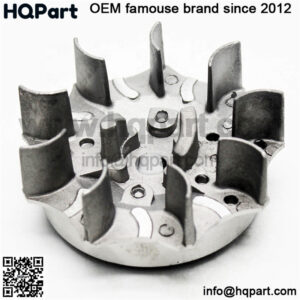4 Signs Of A Bad Flywheel You Shouldn’t Ignore
1. The Clutch Will Slip When In Gear
If you experience a slight lack of power or a surging engine straight after you change gears, this can be a sign of a slipping clutch. It is also possible for a worn clutch to slip when driving under load or up a steep hill.
The clutch slipping, is caused by a worn clutch plate or problem with clutch pressure plate, the release bearing or the flywheel. In many cases, a faulty flywheel will cause the clutch friction disc to wear out early.
If the flywheel is not spinning smoothly or is causing jerky gear changes, this can damage the clutch plate, leading eventually to a slipping clutch. This is why it is important to inspect the flywheel for damage or faults when performing a clutch replacement.
2. It’s Difficult To Change Gear
A vehicle with a failing flywheel can be more difficult to drive as it can be harder to change gears. This is because the clutch plate is not fully disengaging from the flywheel when you press the clutch pedal.
There can be many reasons why the clutch plate doesn’t move fully. It can be caused by a lack of clutch fluid causing low pressure. It can also be caused by a bad clutch release bearing.
If the flywheel is causing the problem, then this is usually because it’s cracked or warped. A cracked flywheel will warp slightly at higher speeds and this can cause problems when trying to change gear.
The problem can also be caused by a failed pilot bearing. When the clutch is disengaged, the pilot bearing allows the flywheel to maintain engine speed as the input shaft is slowing down and stopping. If a pilot bearing has failed then the input shaft is no longer held in place and can move around making it difficult to select a gear.
3. There’s A Vibration In The Clutch Pedal
A vibration in the clutch pedal is caused be a worn clutch plate that does not sit flat against the flywheel.
This can be caused by a bad flywheel that is vibrating as it has warped or cracked. The damaged flywheel causes the clutch plate to wear unevenly and this will stop them from engaging fully.
A vibrating clutch pedal is often worse when accelerating or just after you change gears. This is because the crankshaft is increasing in speed and the extra torque and engine vibrations are absorbed by the flywheel and passed to the clutch plate when you take your foot off the pedal.
The vibrations can also be caused by clutch misalignment, problems with the throw out bearing or problems with the clutch diaphragm spring. In many cases, it is a problem with other parts of the clutch assembly that can initiate a problem with the flywheel.
4. Burning Smell And Rattling Noises
If there is a problem with the operation of the flywheel and how it is interacting with the clutch plate, then it is inevitable that there will be rattling and grinding noises due to the speed at which these parts move.
One of the more common warped flywheel symptoms is a bad burning smell from underneath your vehicle, especially when the vehicle is under load, going up a steep hill slowly, if you are stuck in stop-go traffic or when reversing slowly.
The burning smell is the clutch plate friction material being worn away as it slips against the surface of the flywheel. If the clutch is operating properly, then the clutch plate should be fully engaged when the vehicle is in gear. If the flywheel is warped or there is a problem with engaging the clutch fully then the plate will slip and will wear away. This will eventually lead to a total failure of the clutch.

